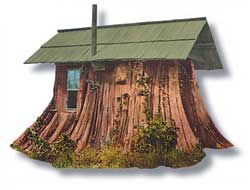Holy Week seems like as good a time as any to talk about tearing down churches.
The beautiful domed First United Methodist Church on Fifth Avenue downtown is about to become history to make way for another Martin Selig skyscraper. By selling out and swapping for some property in Belltown, the congregants can continue to minister to the poor and homeless while being freed from feeding a money-sucking white elephant. With plenty of empty pews, many argue, it seems like the sensible thing to do. After all, what would Jesus do?
Preservationists argue that the sellout is a travesty. The historic church is an architectural gem. Sitting at the stoplight at Fifth and Madison Street, viewing the sun-dappled dome against the backdrop of Selig’s massive Columbia Tower, it is sickening to imagine that Seattle would let such a magnificent structure disappear from the city’s core. It provides just the kind of architectural and historical layering urbanists are always going on about—the old and new creating a unique patina.
Even the mayor’s minions, like Deputy Mayor Tim Ceis, are lamenting the Methodist church’s impending loss. “If downtown is all high-rises, you lose the character. That’s what’s at risk,” he told the Seattle Post-Intelligencer on April Fool’s Day. Was he joking? This is one of the guys who recently cleared the decks for an unprecedented high-rise boom downtown. By removing and raising downtown height restrictions, the city has just engineered an enormous public giveaway, the privatizing of our airspace, our view corridors, even our sunlight. We’ll get a comparatively few “affordable” housing units in exchange. They’ve greased the skids for high-rise growth.
The most ardent proponents of these growth policies have argued that radical change in Seattle is necessary to preserve the rural countryside. We have been told that our sacrifice inside the city limits (city of no limits?) will help keep the region green. Seattle’s “character” is one of the eggs that must be broken to make this omelet.
Unfortunately, the promise is nonsense. Big growth in downtown Seattle won’t be a sponge for regional growth. In fact, it will likely drive additional growth in the region—just look at the San Francisco Bay Area, which has sprawled endlessly despite San Francisco’s higher densities and incomes. A Seattle boom will generate more sprawl and more density, in part because we don’t have the strict growth controls in place to truly limit it. There is simply too much developable land. And despite revitalized inner cities in recent years, people still want single family homes. Seattle’s large stock of such housing is becoming increasingly unaffordable. Joel Kotkin, senior fellow at the New America Foundation, writes that 85 percent of post-2000 growth is in the suburbs. High-rise condos won’t change those dynamics.
If the bargain is that the city must give up something for the greater good, what are we losing? Our moderate-sized metropolis will become more crowded; our residential neighborhoods will lose more of their yards and open spaces to bigger or taller houses and condo complexes; families will continue to look elsewhere for quality of life; the legendary democratic landscape will become increasingly the preserve of the well-off. The urbanized city will be looking to squeeze every dollar it can from citizens, from soaking us at the parking meter (see “Parking Sticker Shock“) to commercializing our parks. And history and character—things established by time and habit—will be ravaged by the wrecking ball more often.
If the leaders of downtown’s First United Methodist Church don’t think their own church is too sacred to tear down, it’s hard for anyone to make an argument that it is. They’re not the only Seattle mainline church to replace old-time religion with a mission that puts a premium on providing social services rather than filling the sanctuary with enthusiastic crowds. If you want those, go to the multimedia suburban megachurches or the urban youth-oriented churches that are as much concert venues as places of worship. With dwindling congregations, some of the older, dying churches have found renewed meaning in feeding, clothing, and sheltering the needy. For that, grand temples are often hindrances.
It may be less picturesque for the rest of us, but the fact is that we now rely on these faith-based services to plug holes in the safety net. We should be thankful that they do it. Perhaps if we fully funded social services, these churches could devote time to other worthy projects, like historic preservation.
In a city of the godless, the sure ticket to survival of religious landmarks is secular use, as with Town Hall—the Christian Science Church converted into a civic temple, the “church of David Brewster,” as Michael Kinsley calls it, referring to Town Hall’s founder. Also witness the immediate and almost religious fervor the masses have shown for the crystal-palace downtown library, a near-perfect melding of high-mindedness, civic function, and social service agency wrapped in a historic landmark of the future. Today, landmarks— and churches—have to do more than look pretty if they’re to last.
Preservationists will have to be more forward thinking than backward looking to stay a step ahead of the developers. You can also bet they won’t always be successful. Look for more collateral damage to our collective “character” as our growth policies play out.







